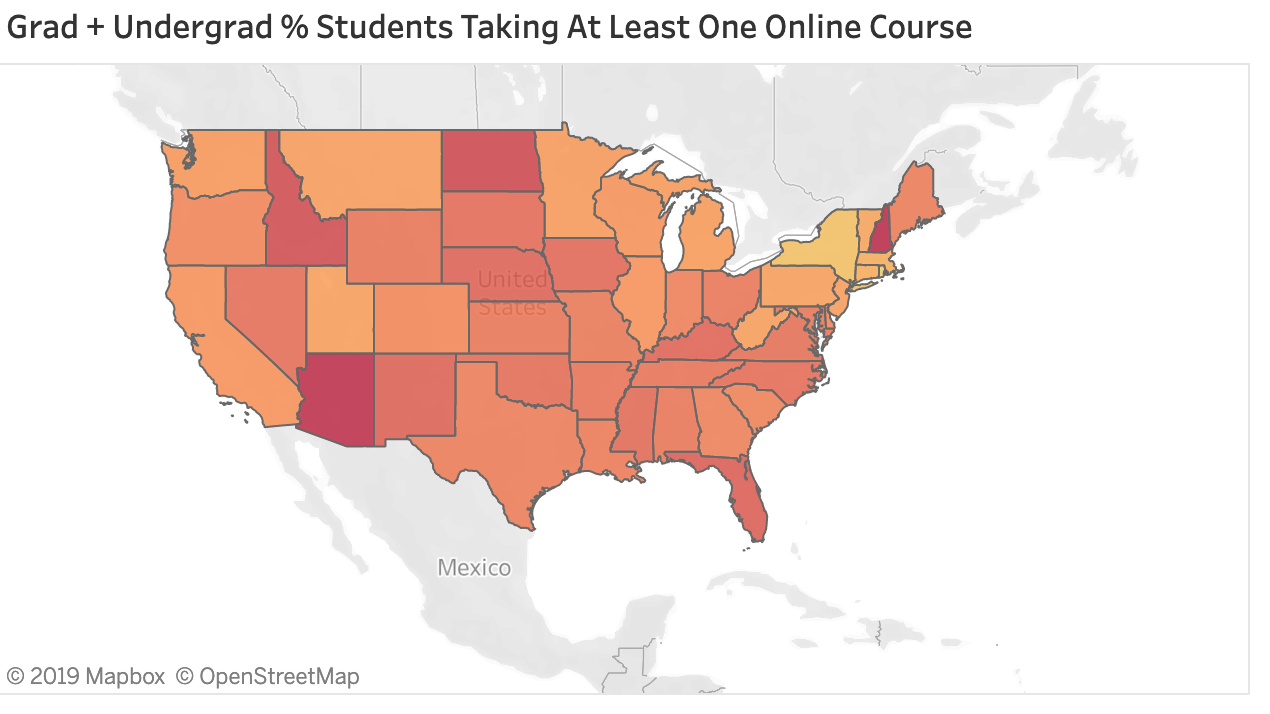
The US Federal government recently released its
The excellent Phil Hill has provided an analysis of this data, including trends since 2012. For data analysis geeks, I strongly recommend you look carefully at Phil Hill’s graphs and tables, as the analysis is relatively nuanced, depending on the type of higher education institution (public or private, 2-year or 4-year), the level of study (graduate or undergraduate), and whether students are taking just some or all their courses online.
I particularly liked the way he graphically presents the differences by state through an interactive map – just click on each state to get its data (see the header graphic above for a non-interactive example).
Main results
- Online/DE continues to grow while overall enrolments continue to decline in the USA (but the trends differ considerably by type of institution: the biggest drop in overall enrolment numbers is in 2 year college enrolments, while overall enrolments in public four year universities have increased by nearly a million since 2012)
- Almost 35% of all post-secondary students in the USA are taking at least one online course (compared with 18% in Canada)
-
In the US, it is far more common to have undergrad students in a mixed mode – taking some online courses and some face-to-face course. Graduate students though are increasingly more likely to take exclusively DE courses.
This is a very brief summary. If you are at all interested in the latest on what’s happening in online learning/distance education in the USA, I strongly recommend you go to:
Hill, P. (2019) Fall 2018 IPEDS Data: New Profile of US Higher Ed Online Education PhilonEdTech, December 8
Hill, P. (2019) US Higher Education Enrollment Trends by Distance Education Type, 2012-2018 PhilonEdTech, December 11
Why not Canada?
Although we at the CDLRA do an excellent job in getting the only real data on online enrolments in Canadian post-secondary education, it comes nowhere near close in quality and reliability to that of the IPEDS data in the USA. In particular:
- the provision of distance education enrolment data in Canada is voluntary; in the USA it is mandatory;
- there are common definitions of distance education for data collection purposes in the USA; there is no ‘official’ definition in Canada;
- there is a major Federal agency in the USA (the Department of Education) with a specific department (the National Centre for Educational Statistics) responsible for data collection in the USA; there is no federal education department, let alone a national centre for educational statistics, in Canada. This comes under the remit of Statistics Canada which is responsible for all government data collection in Canada, but education is a provincial, not a federal, responsibility. As a result, Statistics Canada has no specific mandate to collect data on online learning;
- this results in major inconsistencies in online enrolment data year-to-year in Canada, compared with the US data.
Collecting such data in Canada is up to a bunch of mainly volunteers who depend on scrabbling for small hand-outs from a range of provincial government agencies, and also on massive technical support from the US-based Babson Research Group. There are strict limits to what can be done with this kind of set-up.
Frankly, this is not good enough, despite our best efforts at CDLRA (the Canadian Digital Learning Research Association). Either the Canadian federal government should take on this responsibility, through a mandate to Statistics Canada, or, preferably, provincial governments collectively should provide regular and adequate funding to CDLRA with institutions mandated to provide the information. Neither course of action though is at all likely. In the meantime Canada has to put up with an inadequate system of data collection on online and distance learning depending on well-meaning but under-resourced volunteers.









 Dr. Tony Bates is the author of eleven books in the field of online learning and distance education. He has provided consulting services specializing in training in the planning and management of online learning and distance education, working with over 40 organizations in 25 countries. Tony is a Research Associate with Contact North | Contact Nord, Ontario’s Distance Education & Training Network.
Dr. Tony Bates is the author of eleven books in the field of online learning and distance education. He has provided consulting services specializing in training in the planning and management of online learning and distance education, working with over 40 organizations in 25 countries. Tony is a Research Associate with Contact North | Contact Nord, Ontario’s Distance Education & Training Network.

